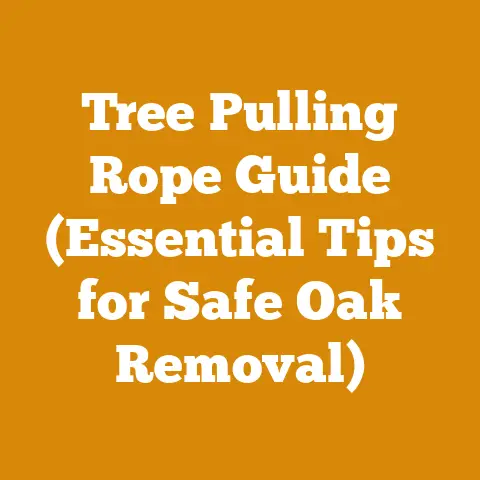Double Wall vs Triple Wall Chimney Pipe (5 Pro Tips for Wood Stoves)
Let’s talk about chimney pipes.
When you’re setting up a wood stove, selecting the right chimney pipe is absolutely crucial.
It’s not just about venting smoke; it’s about safety, efficiency, and the longevity of your entire heating system.
I’ve seen firsthand how a poorly chosen or installed chimney can lead to everything from minor smoke issues to devastating house fires.
Over the years, I’ve worked with countless wood stoves, dealt with various chimney setups, and learned (sometimes the hard way) what works and what doesn’t.
So, let’s dive into the world of double-wall versus triple-wall chimney pipes, and I’ll share some pro tips to help you make the best choice for your wood stove.
Double Wall vs. Triple Wall Chimney Pipe (5 Pro Tips for Wood Stoves)
The heart of this discussion lies in understanding the nuances of double-wall and triple-wall chimney pipes.
Both are designed to vent exhaust from wood stoves, but their construction and performance differ significantly.
Choosing the right one depends on several factors, including your stove type, local building codes, and the specific requirements of your installation.
1. Understanding Chimney Pipe Basics
Before we delve into the double-wall vs.
triple-wall debate, let’s cover some fundamental chimney pipe concepts.
- Draft: This refers to the flow of air up the chimney.
A good draft is essential for efficient combustion and preventing smoke from entering your home.
Factors influencing draft include chimney height, diameter, and temperature difference between the flue gases and the outside air. - Flue Gases: These are the hot, often corrosive gases produced by burning wood.
They contain byproducts like creosote, which can accumulate in the chimney and pose a fire hazard. - Creosote: A tar-like substance formed when wood smoke condenses in the chimney.
It’s highly flammable and requires regular cleaning to prevent chimney fires.
Different types of wood and burning practices affect creosote buildup.
For example, burning unseasoned wood produces significantly more creosote than burning well-seasoned wood. - Clearances: These are the minimum distances required between the chimney pipe and combustible materials like wood framing or drywall.
Proper clearances are crucial for preventing fires.
Building codes dictate these clearances, and they vary depending on the type of chimney pipe. - UL Listing: Underwriters Laboratories (UL) is a safety certification organization.
A UL listing indicates that a chimney pipe has been tested and meets specific safety standards.
Always use UL-listed chimney components for your wood stove installation.
2. Double-Wall Chimney Pipe: The Workhorse
Double-wall chimney pipe consists of two layers of metal with an air space in between.
This design provides better insulation than single-wall pipe, reducing the risk of creosote condensation and improving draft.
- Construction: Typically made of stainless steel or aluminized steel.
The inner wall is designed to withstand high temperatures and corrosive flue gases, while the outer wall provides structural support and reduces heat transfer. - Clearances: Generally requires less clearance to combustible materials than single-wall pipe but more than triple-wall.
This is a key factor in installations where space is limited.
Typical clearances range from 6 to 12 inches, depending on the manufacturer and local codes.
Always consult the manufacturer’s specifications and local building codes for specific clearance requirements. - Applications: Suitable for many residential wood stove installations, especially where the chimney runs through living spaces.
It’s a good balance of cost and performance. - Pros:
- Improved draft compared to single-wall pipe.
- Reduced creosote buildup compared to single-wall pipe.
- Lower cost than triple-wall pipe.
- Cons:
- Higher clearance requirements than triple-wall pipe.
- Not as efficient at maintaining flue gas temperature as triple-wall pipe, potentially leading to more creosote in certain situations.
My Experience: I once helped a friend install a wood stove in his cabin.
The chimney had to pass through a tight space near a wooden beam.
Using double-wall pipe allowed us to meet the required clearances without major structural modifications.
However, we made sure to use a chimney thermometer to monitor flue gas temperatures and adjusted his burning habits to minimize creosote buildup.
3. Triple-Wall Chimney Pipe: The Premium Option
Triple-wall chimney pipe features three layers of metal with two air spaces in between.
This design provides superior insulation, resulting in even better draft and reduced creosote condensation.
- Construction: Similar materials to double-wall pipe, but with an additional layer of metal and insulation.
Some triple-wall pipes use ceramic fiber insulation in the air spaces for enhanced thermal performance. - Clearances: Offers the lowest clearance requirements to combustible materials, often as little as 2 inches.
This is a major advantage in tight installations or when running the chimney through walls or ceilings. - Applications: Ideal for high-efficiency wood stoves, installations with limited clearances, or situations where minimizing creosote buildup is a top priority.
- Pros:
- Excellent draft performance.
- Minimal creosote buildup.
- Lowest clearance requirements.
- Increased safety due to lower surface temperatures.
- Cons:
- Higher cost than double-wall pipe.
- May not be necessary for all wood stove installations.
My Experience: I used triple-wall chimney pipe when installing a high-efficiency wood stove in my own home.
The stove was located near a finished wall, and the minimal clearance requirements of the triple-wall pipe made the installation much easier and safer.
I also noticed a significant improvement in draft compared to my previous stove with a double-wall chimney.
4. Pro Tip 1: Understanding Your Wood Stove’s Requirements
The first and most crucial step is to consult your wood stove’s manual.
The manufacturer specifies the type of chimney pipe required for safe and efficient operation.
This information is often found in the installation section of the manual.
- BTU Rating: The British Thermal Unit (BTU) rating of your stove indicates its heat output.
Higher BTU stoves typically require larger diameter chimney pipes to handle the increased volume of flue gases. - Stovepipe Connector: The stovepipe connector is the section of pipe that connects directly to the stove.
It’s typically single-wall pipe and requires a specific distance from combustible materials. - Chimney Height: The height of your chimney affects draft.
A taller chimney generally produces a stronger draft.
The manufacturer’s instructions will specify the minimum and maximum chimney height for your stove.
Example: My friend purchased a used wood stove without the original manual.
We contacted the manufacturer (luckily, they were still in business) and obtained a digital copy.
The manual clearly stated that the stove required a 6-inch diameter, UL-listed double-wall chimney pipe with a minimum height of 15 feet.
Following these specifications ensured a safe and efficient installation.
5. Pro Tip 2: Local Building Codes and Regulations
Building codes vary by location and often dictate specific requirements for wood stove installations, including chimney pipe types, clearances, and inspection procedures.
- Permits: Most jurisdictions require a permit for installing a wood stove.
Obtaining a permit ensures that your installation meets local building codes and is inspected by a qualified professional. - Inspections: A building inspector will examine your installation to verify that it complies with all applicable codes.
This includes checking clearances, chimney height, and the proper installation of chimney components. - Insurance: Your homeowner’s insurance policy may be affected by your wood stove installation.
Contact your insurance company to ensure that your policy covers wood stove-related incidents.
My Experience: I once skipped the permit process for a wood stove installation, thinking I could save time and money.
However, a neighbor reported the unpermitted installation, and I was forced to remove the stove and reinstall it with a permit and inspection.
The process ended up costing me more time and money in the long run.
Lesson learned: always obtain the necessary permits before starting any wood stove project.
6. Pro Tip 3: Clearance is King
Clearance to combustible materials is paramount for preventing fires.
Always adhere to the manufacturer’s specifications and local building codes regarding clearances.
- Wall Shield: A wall shield is a non-combustible barrier that reduces the clearance required between the chimney pipe and a combustible wall.
They are typically made of metal or masonry and are installed according to the manufacturer’s instructions. - Ceiling Support Box: A ceiling support box is used to support the chimney pipe as it passes through a ceiling.
It provides a fire-safe barrier between the chimney and the ceiling joists. - Thimble: A thimble is a metal or ceramic sleeve that is installed in a wall where the chimney pipe passes through.
It provides a fire-resistant barrier and protects the wall from heat damage.
Example: I helped a client install a wood stove in a small cabin with limited space.
The chimney had to pass close to a wooden wall.
We used triple-wall chimney pipe with a wall shield to achieve the minimum required clearance.
We also installed a chimney thermometer to monitor the surface temperature of the pipe and ensure that it remained within safe limits.
7. Pro Tip 4: Choosing the Right Diameter
The diameter of your chimney pipe is critical for proper draft and efficient combustion.
The manufacturer’s instructions will specify the required diameter for your wood stove.
- Undersized Chimney: An undersized chimney can restrict airflow, leading to poor draft, smoke spillage, and increased creosote buildup.
- Oversized Chimney: An oversized chimney can cause flue gases to cool too quickly, leading to condensation and creosote formation.
- Adapters: Avoid using adapters to connect chimney pipes of different diameters.
Adapters can create turbulence and reduce draft efficiency.
My Experience: I once encountered a situation where a homeowner had installed an oversized chimney pipe on his wood stove.
The stove produced excessive smoke and creosote.
After replacing the oversized pipe with the correct diameter pipe, the stove performed much better, with improved draft and reduced smoke emissions.
8. Pro Tip 5: Proper Installation Techniques
Proper installation is essential for the safety and efficiency of your wood stove system.
Follow the manufacturer’s instructions carefully and use high-quality chimney components.
- Chimney Height: Ensure that your chimney extends at least 3 feet above the highest point where it passes through the roof and at least 2 feet higher than any part of the building within 10 feet.
- Sealing Joints: Use high-temperature sealant to seal all joints between chimney pipe sections.
This prevents flue gases from leaking into your home. - Support: Provide adequate support for your chimney pipe.
Use chimney supports or brackets to prevent the pipe from sagging or collapsing. - Cleanout: Install a chimney cleanout at the base of your chimney.
This allows you to easily remove creosote and debris. - Chimney Cap: Install a chimney cap to prevent rain, snow, and debris from entering the chimney.
A chimney cap also helps to improve draft.
Case Study: I was called in to inspect a wood stove installation that was experiencing significant smoke spillage.
Upon inspection, I discovered several issues, including a poorly sealed chimney cap, inadequate chimney height, and missing chimney supports.
I corrected these issues, and the smoke spillage problem was resolved.
This experience highlighted the importance of proper installation techniques for wood stove safety and performance.
9. Wood Selection and Burning Practices
Even the best chimney system can’t compensate for poor wood selection and burning habits.
Using seasoned wood and burning efficiently are crucial for minimizing creosote buildup and maximizing heat output.
- Seasoned Wood: Seasoned wood has a moisture content of 20% or less.
It burns cleaner and produces more heat than green wood.
Seasoning wood typically takes 6-12 months, depending on the type of wood and climate. - Green Wood: Green wood has a high moisture content, typically 50% or more.
It burns inefficiently, produces excessive smoke and creosote, and can damage your wood stove. - Wood Species: Different wood species have different burning characteristics.
Hardwoods like oak, maple, and beech burn hotter and longer than softwoods like pine and fir. - Burning Practices: Avoid smoldering fires, as they produce more smoke and creosote.
Burn hot, clean fires with plenty of air.
My Experience: I used to burn green wood in my wood stove, thinking I was saving money.
However, I quickly realized that the green wood produced excessive smoke and creosote, requiring more frequent chimney cleanings.
I switched to seasoned wood, and the difference was remarkable.
The stove burned cleaner, produced more heat, and required less maintenance.
10. Chimney Maintenance and Cleaning
Regular chimney maintenance and cleaning are essential for preventing chimney fires and ensuring the safe operation of your wood stove.
- Inspection: Inspect your chimney regularly for signs of damage or creosote buildup.
Look for cracks, loose bricks, or excessive creosote accumulation. - Cleaning: Clean your chimney at least once a year, or more frequently if you burn a lot of wood or use green wood.
You can hire a professional chimney sweep or clean the chimney yourself using a chimney brush. - Creosote Removal: Creosote is highly flammable and must be removed regularly to prevent chimney fires.
Use a chimney brush to scrub the inside of the chimney and remove creosote deposits. - Professional Inspection: Have your chimney inspected by a qualified chimney sweep at least once every three years.
A professional inspection can identify potential problems that you may not be able to see yourself.
My Experience: I had a close call with a chimney fire several years ago.
I had neglected to clean my chimney for too long, and creosote had built up to a dangerous level.
Fortunately, I caught the fire early and was able to extinguish it before it caused serious damage.
This experience taught me the importance of regular chimney maintenance and cleaning.
11. Tools and Equipment
Having the right tools and equipment can make wood processing and firewood preparation easier and safer.
- Chainsaw: A chainsaw is essential for felling trees and cutting logs into manageable lengths.
Choose a chainsaw that is appropriate for the size of trees you will be felling.
I prefer using a Stihl MS 261 for most of my wood processing tasks.
It’s powerful enough for most jobs, yet lightweight and easy to handle. - Axe: An axe is useful for splitting firewood and felling small trees.
A splitting axe with a heavy head is ideal for splitting large logs. - Log Splitter: A log splitter can significantly reduce the effort required to split firewood.
Hydraulic log splitters are available in various sizes and power levels.
I use a 27-ton hydraulic log splitter, which makes splitting even the toughest logs a breeze. - Safety Gear: Always wear appropriate safety gear when working with wood, including safety glasses, hearing protection, gloves, and steel-toed boots.
- Moisture Meter: A moisture meter is used to measure the moisture content of wood.
This is essential for ensuring that your firewood is properly seasoned.
12. Felling Techniques
Proper felling techniques are crucial for safely and efficiently harvesting trees.
- Planning: Before felling a tree, assess the surrounding area for potential hazards, such as power lines, buildings, and other trees.
Plan your escape route and ensure that it is clear of obstacles. - Notch Cut: The notch cut is a wedge-shaped cut that directs the tree’s fall.
Make the notch cut on the side of the tree that you want it to fall towards. - Back Cut: The back cut is made on the opposite side of the tree from the notch cut.
Leave a hinge of wood between the notch cut and the back cut to control the tree’s fall. - Felling Wedge: Use a felling wedge to help push the tree over in the desired direction.
Case Study: I was once helping a friend fell a large oak tree.
We carefully planned the felling operation, made the notch cut and back cut, and inserted a felling wedge.
As we hammered the wedge, the tree began to lean in the desired direction and fell safely to the ground.
This experience demonstrated the importance of proper felling techniques for safely harvesting trees.
13. Debarking Logs
Debarking logs can help to speed up the drying process and reduce the risk of insect infestation.
- Drawknife: A drawknife is a traditional tool used for debarking logs.
It consists of a blade with two handles that is pulled along the surface of the log to remove the bark. - Debarking Spud: A debarking spud is a metal tool with a curved blade that is used to pry the bark off of logs.
- Power Debarker: Power debarkers are available for large-scale debarking operations.
14. Splitting Firewood
Splitting firewood can be a challenging task, but with the right tools and techniques, it can be made easier and safer.
- Splitting Block: Use a sturdy splitting block to provide a stable surface for splitting firewood.
- Axe: A splitting axe with a heavy head is ideal for splitting large logs.
- Log Splitter: A log splitter can significantly reduce the effort required to split firewood.
- Wedges: Use wedges to split logs that are too difficult to split with an axe.
My Insight: I’ve found that the key to efficient firewood splitting is to choose the right tool for the job and to use proper technique.
For smaller logs, an axe works well.
But for larger, more difficult logs, a hydraulic log splitter is the way to go.
It saves a lot of time and energy.
15. Firewood Stacking
Proper firewood stacking is essential for maximizing air circulation and promoting drying.
- Elevated Stacking: Stack firewood on pallets or other elevated surfaces to allow for air circulation underneath the stack.
- Crisscross Stacking: Crisscross the ends of the stack to provide stability and promote air circulation.
- Sun Exposure: Stack firewood in a sunny location to speed up the drying process.
- Covering: Cover the top of the stack with a tarp to protect the firewood from rain and snow.
Case Study: I once helped a neighbor stack his firewood in a disorganized pile on the ground.
The firewood took a long time to dry and was prone to rot.
I showed him how to stack the firewood properly on pallets, crisscrossing the ends of the stack and covering the top with a tarp.
The firewood dried much faster and stayed in good condition.
16. Drying Methods
Drying firewood is crucial for efficient combustion and minimizing creosote buildup.
- Air Drying: Air drying is the most common method of drying firewood.
It involves stacking firewood in a well-ventilated location and allowing it to dry naturally. - Kiln Drying: Kiln drying is a faster method of drying firewood.
It involves placing firewood in a kiln and heating it to a specific temperature to remove moisture. - Solar Drying: Solar drying uses the sun’s energy to dry firewood.
It involves stacking firewood in a greenhouse or other enclosed space and allowing the sun to heat the air and remove moisture.
My Experience: I’ve found that air drying is the most practical method for drying firewood in my climate.
It takes longer than kiln drying, but it’s less expensive and requires less equipment.
I typically stack my firewood in the spring and allow it to dry throughout the summer and fall.
By winter, it’s ready to burn.
17. Strategic Advantages of Each Method and Tool
Each method and tool offers unique strategic advantages in wood processing and firewood preparation.
- Hydraulic Splitter: Increases efficiency and reduces physical strain compared to manual splitting.
- Chainsaw: Enables quick and efficient felling and bucking of trees.
- Seasoned Wood: Provides more heat, burns cleaner, and reduces creosote buildup.
- Triple-Wall Chimney: Offers superior insulation, minimizing creosote and maximizing draft.
18. Costs and Material Specs
Understanding the costs and material specifications is essential for budgeting and planning your wood processing and firewood preparation projects.
- Chainsaw Costs: Vary depending on size and features, ranging from $200 to $1000 or more.
- Log Splitter Costs: Hydraulic log splitters range from $1000 to $3000 or more.
- Firewood Costs: Vary depending on location and wood species, typically ranging from $150 to $400 per cord.
- Moisture Content Targets: Seasoned firewood should have a moisture content of 20% or less.
- Drying Times: Air drying typically takes 6-12 months, depending on the type of wood and climate.
19. Skill Levels Required
Wood processing and firewood preparation require varying skill levels, depending on the task.
- Chainsaw Operation: Requires training and experience to operate safely.
- Axe Splitting: Requires technique and physical strength.
- Log Splitter Operation: Relatively easy to learn, but requires caution.
- Chimney Installation: Requires knowledge of building codes and safety standards.
20. Next Steps and Implementation Guidance
Ready to start your own wood processing or firewood preparation projects?
Here are some practical next steps and implementation guidance:
- Research: Research local building codes and regulations regarding wood stove installations.
- Plan: Plan your wood processing and firewood preparation projects carefully, considering safety, efficiency, and environmental impact.
- Gather Tools: Gather the necessary tools and equipment, including a chainsaw, axe, log splitter, and safety gear.
- Season Wood: Start seasoning your firewood well in advance of the heating season.
- Install Chimney: Install your chimney according to the manufacturer’s instructions and local building codes.
- Maintain Chimney: Maintain your chimney regularly by inspecting it for damage and cleaning it to remove creosote.
Choosing between double-wall and triple-wall chimney pipe comes down to understanding your specific needs and priorities.
Consider your wood stove type, local building codes, clearance requirements, and budget.
By following these pro tips, you can ensure a safe, efficient, and long-lasting wood stove system for years to come.
Remember, safety is paramount, so always prioritize proper installation and maintenance.
Good luck, and happy burning!






